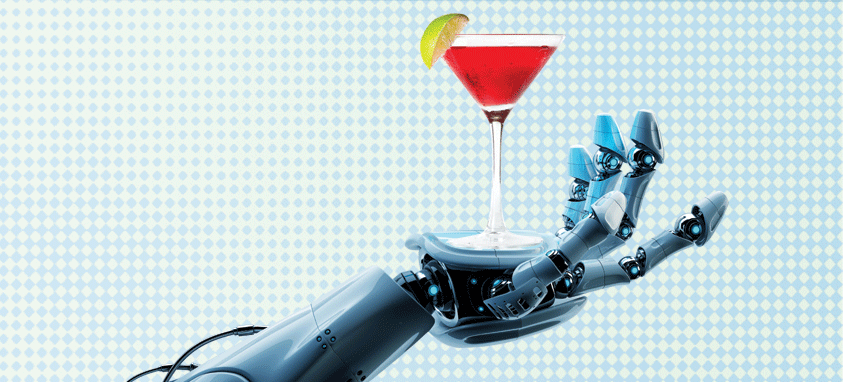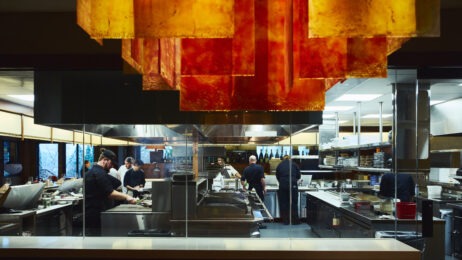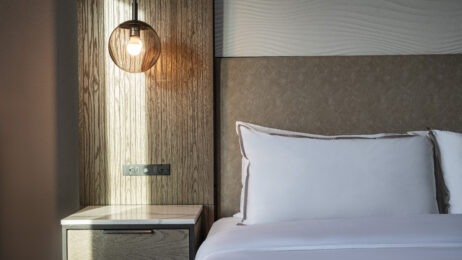Quick, name a famous hotel meeting room. No offense to those spaces where we spend so many important hours, but they tend to be remembered for what planners bring to them rather than for themselves. Now name a famous hotel bar. Ahhh, that’s a different story. Hotel bars, in fact, have unending stories.
Imagine yourself, for example, at American Bar at The Savoy, a Fairmont property in London, which was named best bar in the entire world in 2017 by World’s 50 Best. Marilyn Monroe is sitting next to you, sipping champagne. The Savoy Cocktail Book has been the classic bartender guide since 1930. You can order an Aloe from the Other Side, named in honor of pop star Adele, who, like The Rolling Stones, Led Zeppelin and other rockers, has partied at Andaz West Hollywood’s Riot House Bar. And talk about inspiration: Ernest Hemingway, Tennessee Williams, William Faulkner and Truman Capote have all occupied one of the 25 revolving seats at Carousel Bar in New Orleans’ Hotel Monteleone.
Bars and hotels have been paired practically forever. According to Guinness World Records, the Priest Inn (now The Bingley Arms) in North Leeds dates to 953 or earlier, making it the oldest hotel pub in Britain. Monks journeying between abbeys grabbed a pint and a bed there. In Miltenberg, Germany, the hotel Zum Riesen and its companionable bar officially date to the 15th century, though local legend traces their origins to the 1100s; that bar has hosted kings—from German kaisers to Elvis Presley.
Today, hotel bars uphold their storied tradition, but they chart new territory, as well. Where once they were places to grab a quick drink after the day’s meetings and before the night’s group dinner, they serve now as hip work spaces and social hubs, play spaces and relaxation zones. And the beverages they offer have morphed into expressions of place, season and mood.
All of this takes forethought and deliberate planning by corporate and brand executives—and property bar teams—to reflect the changing expectations and needs of business and leisure travelers. So, here’s another story for you, a tale of the hotel bar of yesterday, today and tomorrow, for the next time a friendly bartender at your hotel asks, “What can I get for you?”
The Evolutionary Past
One of the great things about a hotel bar is that its clientele can be from anywhere, kind of like the bar scene in the first Star Wars. Meeting-goers. Tourists. Locals. Yet just who that clientele is—and what they experience at these watering holes—has changed dramatically over the decades.
Are you old enough to remember when an unescorted “decent” woman thought twice about claiming a hotel barstool? When an old-school bartender’s glance could be withering if you ordered a nonalcoholic drink? When peanuts or pretzels was about as good as it got unless you migrated to the hotel dining room?
Men did deals and held hushed meetings under a cloud of cigarette smoke at a hotel bar’s booths or tables, but women? Forgettaboutit…They went shopping.
Which points to a key evolution. Hotel bars today have become social hubs in the way retail once was, especially as women and generations of every gender have blurred the line between work and play, and have taken rightful places in what was formerly a male preserve of traveling salesmen and conventioneers.
“The bar used to be a waiting area to get to the restaurant itself,” remembers Mike Ryan, director of bars for Kimpton Hotels & Restaurants, an InterContinental Hotels Group brand. “You ordered a drink and maybe a snack to tide you over until your table was ready. Now, bars are F&B destinations in themselves, where people have full culinary and cocktail experiences.”
He adds: “We’ve also made subtle and not-so-subtle changes for them to be more flexible spaces. Double Take at Kimpton Palomar Beverly Hills Los Angeles, for instance, is essentially a grown-up game room and a perfect place for groups to hang out in. Whether it’s plentiful outlets and Wi-Fi, or having the space accessible outside of open bar hours, it’s meant to offer more than just drinks.”
Devin Burns, vice president of food and beverage at Omni Hotels & Resorts, agrees. “The bar is now seen as a communal and welcoming space for all,” he says. “It is where business and leisure guests can dine, relax, plug-in and enjoy great local cuisine perfectly paired with a crafted beverage, coffee, a full meal or a lighter, healthier snack. Single travelers and groups are attracted to the energy and open space that the bar offers.” Omni hotels, he says, strive for a balance between comfort, convenience and engagement.
The Strategic Presentations
None of these changes happen by accident.
Tucked into Marriott International headquarters in Bethesda, Maryland, for example, is BarStudio, the company’s beverage incubator. A bar-and-beverage innovation team works to express Marriott’s individual brands in bar ambience and menus, and it coaches visiting bar teams from Marriott-managed properties.
“They inspire one another and end up taking back recipes, stories and learnings—an organic instead of a forced cross pollination of information,” says Angela Kuzma, global vice president of restaurants and bars. To broaden this sharing of what works, Marriott also launched an initiative called Diary of the Craft, a toolkit of success stories as well as “the personal and professional journeys of our artisans and talent,” says Kuzma.
BarStudio innovates bar design for Marriott, too. “Designing a bar space that allows each guest to feel authentic to themselves is far more impactful than building out a space that’s one dimensional,” Kuzma says. “A guest in jeans and sneakers or a suit should feel just as comfortable walking into a luxury hotel bar as they do playing pool at a dive bar. There are so many nuances to getting it just right, but the key is to create a whole experience built within the character of the design’s point of view.”
“When we’re ‘concepting’ our bars, we take a holistic approach,” Kimpton’s Ryan says. “We think about the sense of arrival, the flow of traffic, the lighting you need for day versus night, the music selection—thanks to our first director of music and brand activations—and the barware we present those beautifully crafted drinks in. If one element is off, it throws the ambience out of balance and impacts what you take away from your visit. A fully concepted, tightly packaged bar offers a seamless, immersive experience.”
Hilton Hotels & Resorts has created what it calls the Wander program for its hotel owners to encourage concepts that evoke a memorable sense of place, says Jonathan Wilson, vice president of customer experience and innovation in food and beverage, and wellness. He cites The Troubadour Hotel New Orleans, Tapestry Collection by Hilton, where the rooftop bar, Monkey Board—named for the highest platform of an oil rig—delivers skyline views made more memorable with Crescent City-style craft cocktails, such as Stone Pie (Cane Land spiced rum, pumpkin-spiced syrup and OJ), and fried-chicken sandwiches.
Meetings hotels flagged by the big hoteliers have cocktail menus that range from tightly controlled, brand-wide selections to a combination of corporate signature drinks and local flavors. At Omni, data-mined guest-buying behavior is combined with input from “master mixologists who have vast knowledge and volumes of consumer data” to create beverage programs that balance trends and traditions. “For example, we know that there will always be an appetite for classic cocktails like the Old Fashioned,” Burns says. “However, we might also offer an Old Fashioned made with tequila instead of whiskey as a fun twist and opportunity for our guests to discover something new.”
Kimpton uses restaurant software to pull bar-specific data. “We cross reference that sales data with anecdotal conversations with bartenders to build a picture of what our guests are drinking,” Ryan says. “A lot of people like vodka— surprise, surprise!”
When it comes to creating cocktail menus, Ryan takes a hands-off approach. “My role is centered on coaching and mentorship. When we open new restaurants and bars, I will develop the initial menu concept, but the best expression of the menu will always be the lead bartender’s,” he says. “Typically, we change our menus seasonally; we establish quarterly spirit features to give our teams a base to work from, and then let them create the actual cocktails and menus so that they can showcase their city and region.”
Burns gives his cocktail program an annual, brand-wide refresh, but he also encourages each hotel to supplement the list to be “genuine and authentic.” Two years ago, he launched Omni Originals, a quarterly culinary and cocktail program with thematic offerings. Last December, that meant Cookie Cocktails—cocktails inspired by classic holiday cookie recipes.
“Unlike food menus, which change largely by season, cocktail menus are much more fluid,” Hilton’s Wilson says, no pun intended. “Parts of the menu can change every single day. Most guests don’t use a menu; they walk in and place an order. Ultimately, this process is a partnership between the F&B lead on property and the mixologist, enabling the mixologist to have creative control. After all, a well-rounded menu can have a significant impact on revenue and profitability.”
Cross-pollination between locales also figures into the cocktail strategy. “Whether it’s a digital bar education program or an in-person off-site, we’re sharing successes and learnings with each other all year round,” Ryan says.
Future Bar
So, what will the happy hour of the future look like? Will drinks be delivered by drone or served by robots? Will cannabis edibles in seasonal, hyper-local flavors be on the menu?
“One thing is for sure: Bartenders and mixologists are not going away,” Wilson says. “Guests want to be entertained, they want to learn, they want to be heard, and having the brand hospitality to represent all of these attributes is what makes the experience memorable. There will be more opportunities for self-serve experiences in terms of conveniences in venues, such as lobby marketplaces, but not as replacements for hospitality.”
“No robot bartenders here!” Ryan echoes. “The reason people go to bars is to be introduced to something new, strike up a conversation with the bartender and if the occasion is right, say ‘hi’ to the person next to you. Bars are social spaces—there’s a lot that can be automated, but the bar experience shouldn’t be one of them.”
The “bar side” manner of human bartenders is as important as the drinks they make, he says. “We have a cheeky Bar Manifesto we post up back-of-house that explains what our standards and principles are in running our bar. From the integrity of ingredients to always, always, always having a welcoming and inclusive attitude for our guests, we expect our teams to check their egos at the door. We hire for heart all the way.”
“Technology will play an increasing role, nonetheless. “I predict that Kimpton bars in the future will find ways to streamline a lot of the awkward mechanical parts of rapid-fire service without compromising the quality of the product or the experience,” Ryan says. “Payment processing is a major speed bump currently. Moving entirely to electronic payments, the way most of China has, will dramatically speed up one of the slowest steps in the bar experience.”
Omni’s Burns agrees that nothing can replace “friendly, guest-focused, anticipatory and high-energy human bartenders. But we always look for ways to incorporate technology and new tools to enhance the bar experience. For example, cocktails and wine on tap are more and more prevalent, and offer advantages for the right space—including speed of service and less waste.”
No one at the big hotel companies is admitting publicly that cannabis will find its way into beverage programs anytime soon. The potential liabilities and uncertainties are still too great. “There’s a separation between an individual choosing to use it for personal reasons and public consumption,” Ryan says. “It’s too dangerous to experiment with certain ingredients without knowing all of the potential risks.” He explained the rationale this way: “At the end of the day, we’re bartenders, not pharmacists, doctors or research physicians. We’re trained to dispense alcohol in a responsible way.”
So, if pot-infused libations won’t be on the hotel bar menu, what will be the Next Big Thing in hotel bars and beverage programs? Hilton’s Wilson has an answer that might surprise you—no alcohol.
“The forward-looking trend is around what we call ‘no proof,’” he says. “No proof is not mocktails. It is an amazing bar experience with no alcohol at all.” In other words, guests will have the option of a great bar and lounge that still offers “a thrilling experience, unique energy and ambiance, great food and service and exciting entertainment”…but without the booze.
Hilton already has no-proof bars in the Middle East, where many business and leisure travelers shun alcohol for religious reasons. Manhattan Sports Diner at Hilton Jeddah and Ambar at Hilton Riyadh Hotel & Residences, both in Saudi Arabia, are two examples.
“As this trend matures in major cities like London and across the Middle East, we will start adding concepts to our properties in the U.S., as well,” Wilson predicts.
Trending Sips
At hotel bars around the country, brown liquors are definitely back in vogue. And so are…
Savory: Beet, mushroom or cheese infusions in a cocktail? How about corn, jicama and sunchokes? Mixologists are playing with nontraditional flavors in the name of being hyper-local, seasonal and (somewhat) healthy. The cacio e pepe martini is an homage to the classic Roman pasta dish of only three ingredients—pasta, Pecorino Romano cheese and black pepper; it’s made with vodka, cheese-infused dry vermouth and black pepper.
Ferments: House-made syrups and tonics that include fermented and probiotic ingredients. Tepache, a traditional Mexican ferment made from pineapple peels, sugar and cinnamon, is being paired with beer, mescal, tequila and even bourbon.
Hard Seltzers: Made with fermented cane sugar and infused with fruit essences, these have the same alcohol content but fewer carbs than a beer, and relatively few calories (roughly 100) for an adult beverage. Paired with vodka, the combined kick demands respect, however.
Exotic Citrus: Bar stalwarts lemon, lime and orange are being joined by lesser-known cousins, such as yuzu, kumquat and citron. Somewhere in flavor between a lime and grapefruit, muddled Japanese yuzu is zesty-yummy when shaken and strained with ice, gin, vanilla extract, bitters and simple syrup.
Far-Out Spices: Saffron, madras curry, cardamom and tamarind are just a few of the spice-bazaar discoveries being made by bartenders to transport you to somewhere out of the ordinary.
One Plus One Equals Whee!: Last year’s trendy faves, frozen rose and the Aperol spritz (Aperol, club soda, orange twist) have been joined to create the slushy Aperol frose, which Kimpton calls the bar star of 2019.
Pompadour
The Statler Dallas, Curio Collection by Hilton, originally opened in 1956 as one of Conrad Hilton’s first convention properties. Its mid-century design with retro-forward touches is exemplified in this specialty cocktail.
- 1 ½ ounce Wild Turkey bourbon
- ½ ounce Diplomatico Reserva Exclusiva rum
- 3 dashes vanilla tincture*
- 3 dashes Angostura bitters
- 1 sugar cube
- 1 orange peel, in strips
- Orange zest, cocktail cherry for garnish
Place sugar cube, Angostura, vanilla tincture and orange peel in a mixing glass and muddle to dissolve the sugar cube and pull the oils out of the orange peel. Add Wild Turkey and Diplomatico to mixing glass with ice and stir. Strain into rocks glass with large ice cubes and top with brulee*. Garnish with orange zest and cherry.
*For vanilla tincture: Slice 15 vanilla beans in half and let steep in quart container of vodka for a week. For brulee: Soak Isomalt “sugar” crystals (available online) with Angostura bitters and lay out on a sheet tray. Heat in oven at 350 degrees for about 15 minutes or until Isomalt is melted. Spread the brulee evenly and let cool for five minutes. Cut into circles to fit the size of the rocks glass.




